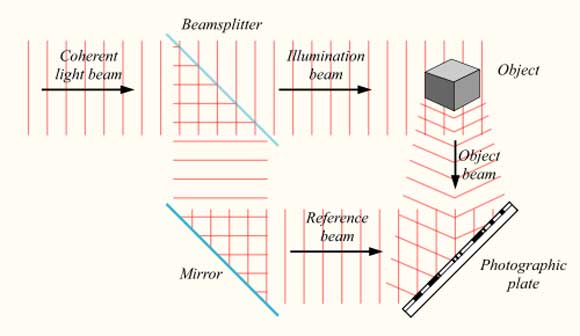Holograms: Virtually Approaching Science Fiction

My Hands Hologramming Themselves is a hologram of the instant my hands pushed the FIRE button on the controller to the pulsed ruby laser, the only laser which emits light powerful and fast enough to record a human.
The reason for this is because any motion in the subject will muddle the electromagnetic wavefront which emanates from the object; it must remain undisturbed in order to be recorded. Because of a person's breath and heartbeat, the light must be very bright and very fast - 20 nanoseconds fast in this case, without even time to blink. –Artist Lori Ann Napoleon
Image courtesy Lori Ann Napoleon
Imagine watching a battleground in Afghanistan change in real-time in 3D from the comfort of a conference room or trouble shooting designs for multi-million dollar instruments without the need for expensive physical models or observing 3D images of living biological specimens reacting to a new treatment in real-time from a classroom.
Like the hologram of Princess Leia asking Obi-Wan Kenobi for help in Star Wars Episode IV: A New Hope and the holographic interface that Tony Stark uses in Iron Man 2 to design his Mark V suit, these applications are still futuristic, but advances in holography are bringing us closer than ever to realizing these possibilities.
The first hologram was made about 50 years ago, the culmination of work by many different research groups. As our understanding of optics has grown and artists and scientists have created new techniques and new types of materials, holograms have changed from crude representations of simple objects to tools used by the medical community (in CAT scans and X-rays), artists (in displays and decorations), businesses (in computer generated images and measurements), and even government agencies (in security).
A hologram is a 3D, virtual image of an object that is created with information stored in a holographic plate. A holographic plate is a kind of recording medium, like a CD. Just as the grooves on a CD contain information that can be used to reconstruct a song, a holographic plate contains information that can be used to reconstruct an object. CDs contain information about sound, and holographic plates contain information about light.
There are a few different kinds of holograms, such as the rainbow holograms on credit cards and bank notes that change color depending on your viewing angle, and reflection holograms often seen in art galleries that display 3D images of an object when illuminated with a ray of white light. Transmission holograms are created through a different process and can only be seen when a laser shines on the holographic plate.

In 2011 the U.S. Government will issue a redesigned $100 bill featuring new security features, including the “Bell in the Inkwell”. Inside the copper-colored inkwell is a hologram of the Liberty Bell that changes color from copper to green when the note is tilted.
Image courtesy U.S. Bureau of Engraving and Printing
Although there are different types of holograms, they all work by recording the interference pattern of light waves caused by an object and recreating that scene when illuminated. For example, to create a transmission hologram you need two beams of laser light (usually one laser is split into two beams, as shown in diagram 1). One beam bounces off of a mirror directly onto the holographic plate (the reference beam) and one illuminates the object. The light scattering off of the object toward the plate interferes with the reference beam, creating a unique interference pattern that is recorded on the holographic plate.
Like an undeveloped photograph, the plate doesn’t look like much at first, but when the object is removed and the plate is illuminated by the reference beam, the pattern of light scattering off of the original object is recreated, revealing a 3D virtual image of the object.

Diagram 2
Holographic reconstruction process.
Image Courtesy DrBob (Wikipedia)
Historically the information recorded in a hologram was permanent, like a song on a CD, and holograms could only be made of still objects. However, emerging holographic techniques and new materials are bringing us closer to the Star Wars vision of creating moving holograms in one place and showing them somewhere else.
Recently a team from the University of Arizona in Tucson led by Dr. Nasser Peyghambarian used a holographic plate made from a new kind of plastic on which you can erase and rewrite holographic information in about two seconds. This enabled them to create holograms of the same object in quick succession.
In order to view the holograms in another location, Dr. Peyghambarian’s team used an array of 16 cameras in one room to record information about the light scattering off of a moving person, and used a software program to turn that information into holographic pixels. This information was sent over the Ethernet to another room, where the information was written onto the holographic plate by lasers. The plastic holographic plate was illuminated, and viewers could see a moving, although choppy, hologram as they image was updated every couple of seconds.
This technology, called telepresence, is still rough around the edges, but it is a great step toward being able to view a changing scene in 3D in close to real-time from a distant location. Holography hasn’t quite caught up to the imagination of science fiction authors, but it is getting closer.















